
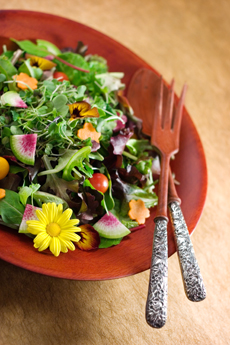 A colorful spring salad is embellished with edible flowers, watermelon radish, heirloom cherry tomatoes and delicate fancy-cut carrot pieces. Photo by Kelly Cline
A colorful spring salad is embellished with edible flowers, watermelon radish, heirloom cherry tomatoes and delicate fancy-cut carrot pieces. Photo by Kelly Cline | IST.
|
MELODY LAN is a member of THE NIBBLE™ editorial staff.
|
|
April 2006
Last Updated April 2018
|
 |
Edible Flowers: Cook, Grow, Buy
Forget The Vase—These Blossoms Go Directly Onto Your Plate!
Page 1: Overview
CAPSULE REPORT: Learn about using beautiful, edible flowers to garnish your cuisine. It’s easy, instant glamour. This is Page 1 of a three-page article. Click on the black links below to visit other pages.
Introduction
For all the times you’ve sent your mother flowers, how often has she been tempted to taste their distinctive, delicate flavors? Probably never. This Mother’s Day, you can change that: forgo the generic FTD arrangement, and present her with edible flowers. We aren’t referring to herbs; we’re talking actual flowers, the beautiful petals you see in bouquets all the time that are used by the finest restaurants and caterers to season and garnish fine food.
One of the best things about edible flowers is that they transform ordinary food into a dazzling creation. Their colors add vibrancy, and the flavors add zest to any dish. A specialty food on the verge of re-discovery by people beyond the inner sanctum of fine chefs, edible flowers are much more accessible than most people might think.
You may have noticed a posy or two pop up as the occasional cocktail garnish or, less often, sprinkled over a mesclun salad. Beyond that, they seldom make appearances in our food. As fans of edible flowers, we’d love nothing more than for them to break out of these cameo roles and star in a variety of dishes. We hope this paean to edible petals will inspire you to try them in some of your own creations, and give them as gifts to some of your favorite home chefs.
|
|
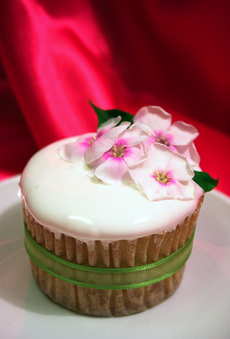
Flowers turn a simple cupcake into a work of art. Photo courtesy CupcakesNouveau.com. |
Flower Power: The History Of Flowers In Food
They may have only had a small part on the U.S. culinary stage, but flowers have played a prominent role in cuisines throughout the world for centuries. Violets have been used by both ancient Egyptians, who crystallized them, and English chefs, who ground them with chicory to make confections. During the Renaissance, audiences of Shakespeare’s plays quenched their thirst with rose-petal water and snacked on delicacies like stewed primroses. Carnation petals are one of the key ingredients in Chartreuse, a green liqueur developed by French monks in the 17th century. Italian and Hispanic cultures stuffed squash blossoms for a hearty dish (and still appear on menus of fine restaurants).
For centuries, flower petals have been widely recognized for their distinctive flavors and artistic qualities, much as fresh vegetables. The flower garden was considered an extension of the vegetable garden, and cooks all over the world sought edible flower petals to enrich and enliven their foods and beverages.
In fact, despite their meager presence in popular American cuisine, edible flowers are popular in other parts of the world. In China and Japan, chrysanthemum petals, a symbol of future joy, are ladled into soup or poured made into tea pitchers—as they have been for more than a millennium. In Mexico, hibiscus flowers are used to make jamaico, a cool drink infusion perfect for refreshment on a hot summer’s day and flavor ice cream and sorbet. Jasmine tea in Asia and mint tea with orange blossoms in North Africa are also popular flower drinks. You’ll see many other food uses in the chart below. |
|
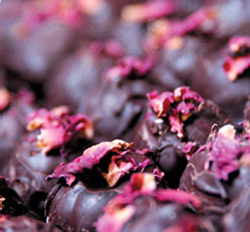
Rose petals decorate fine chocolates by
Fritz Knipschildt. |
The Flower Renaissance
If flowers were such a popular part of cuisine in our English heritage, why has this versatile, beautiful and virtually calorie-free food faded from the our culinary world? As home gardens and personal cooks disappeared after World War I, as food trends changed and more ornate dishes gave way to simpler cuisines prepared by the lady of the house and not by a servant, as food trends changed and caterers and restaurants turned their interests elsewhere. There has been a renewed interest in edible flowers in recent years, which has been encouraging.
|
|
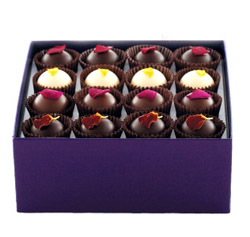
Blossoming truffles from Vosges Haut
Chocolat are decorated with (from top)
marigold, nasturtium, rose and orchid
petals. Photo courtesy Vosges. |
Still, we find that edible-flower options in restaurants are limited. With any luck, that will change with time; until then, we’ll have to be content scouring our local farmer’s markets and specialty food shops for flowers to add to our soups, toss in stir-fries and roast with pork tenderloins.
|
|
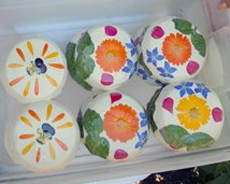
Goat cheeses beautifully decorated with calendula, cornflowers and basil leaves. The cheeses are available from HarleyFarms.com. |
Lifestyle Direct, Inc. All rights reserved. Images are the copyright of their respective owners.

|





